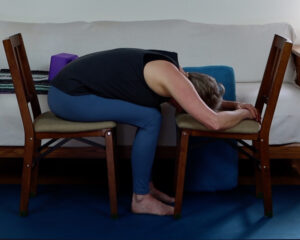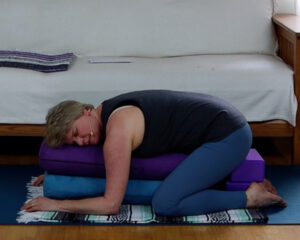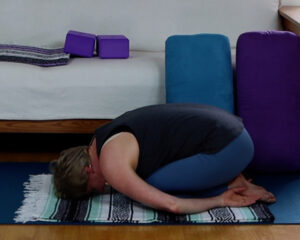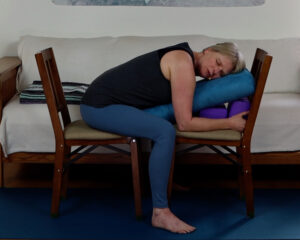 We can use our breath (pranayama) to promote relaxation and healing as we go through Total Hip Replacement preparation and surgery.
We can use our breath (pranayama) to promote relaxation and healing as we go through Total Hip Replacement preparation and surgery.
Breathing is an involuntary action of the autonomic nervous system;* it happens whether we are thinking about it or not. But breathing is also one of those involuntary actions that we can control.
The way we choose to breathe can activate either our sympathetic nervous system — the aspect of our autonomic nervous system related to fight or flight or excitement and action, or our parasympathetic nervous system — the aspect of our autonomic nervous system related to resting, digesting, and healing.
When we are active, in an athletic yoga class, running from danger, or intensely concentrating, our sympathetic nervous system kicks in. Our breathing rate tends to increase, filling the lungs more deeply, widening bronchial tubes, and narrowing pulmonary blood vessels. Our body becomes taught, abdominal muscles tighten. We are ready for action. With this tautness, especially in the belly, the breath must be accommodated in the chest. This kind of “chest breathing” is associated with our sympathetic nervous system.
When we are relaxing, meditating, sleeping, or enjoying a soothing massage, our parasympathetic nervous system is activated. Our breathing slows, the body relaxes, bronchial tubes narrow, and the pulmonary blood vessels widen. The body relaxes and breathing happens more naturally in the belly. This “belly breath” is associated with the parasympathetic nervous system.
The sympathetic nervous system serves us well when we are active and productive or if we are fleeing from danger. The parasympathetic nervous system supports relaxation and healing. Both are essential [but both are different responses to very different things].
The trouble is that sometimes our bodies are dealing with consistent pain or stress. This can be the case when we are going through total hip replacement. The result is a constant stimulation of the sympathetic nervous system and a disruption of sleep or the ability to relax which makes it difficult to access our parasympathetic nervous system so it can do its job.
This is when breathing (Pranayama) with intention and breathing in a way that activates the parasympathetic nervous system serves us well. Intentional breathing overrides unconscious breath patterns and gives us a choice about how we want to breathe.
Breathing Practices:
The first step of a breathing practice is to start by observing what your breath is like in the present moment. At the beginning of any pranayama (breathing) practice take a few moments to:
1) Find a comfortable position either seated or lying down with your head slightly elevated.
2) Sit or lie quietly for a few moments and notice how your body feels. Take note of any sensations. Notice places where you feel pain. Notice places where you do not feel pain.
3) Turn your attention to your breath without trying to change anything. When you inhale do you feel the expansion more in your chest or more in your belly.
4) Notice these things without expectation or judgement. Imagine you are an impartial observer who is curious and caring about what is going on this body.
Take a belly breath!
Regularly engaging in belly breathing can help you turn a fight-or-flight response into a relaxation response that can benefit your health. Our most relaxed and normal way of breathing is in to our bellies, as we do when we are sleeping. A belly breath stimulates the vagus nerve** which activates your parasympathetic nervous system and it also activates your relaxation response which lowers your heart rate, blood pressure and stress levels. When we are in this relaxed state we heal better and we build resiliency to stressors like pain. And the great thing is that we can do belly breathing at will.
Practice belly breath in child’s pose [see variations below]:
1) Find a comfortable position in child’s pose.
2) Notice how your thighs or pillow or bolster puts pressure on your belly.
3) Breathe in deeply, intentionally expanding your belly into your thighs or bolster.
4) Breathe out slowly, trying to make the exhale longer than the inhale by a few beats.
5) Repeat these inhales and exhales 4-5 times and then rest.
6) Rest, breathing naturally for a few repetitions.
7) Repeat steps 3 – 6 several more times.
8) Rest in Corpse Pose
9) An alternative to Child’s Pose is to do the same belly breathing with your hands or a bolster or a blanket on your tummy. Breathe in to their weight.
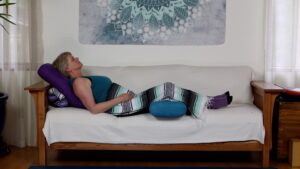
Some other practices that stimulate a relaxation response:
1) Ocean Breath/Ujjayi (the restriction in the throat stimulates the Vagus Nerve and the Parasympathetic Nervous System) or Kumbhaka (Breath retention that also stimulates the vagus nerve, especially when held on the inhale)
2) Any Restorative Yoga Pose (https://yogaforhipreplacement.com/restorative-yoga-total-hip-replacement/)
3) Getting a massage.
4) Lying with your feet above your head.
5) Going for a walk outside, in nature.
6) Lying with a weight, like a blanket, on your belly.
7) A quiet meditation sesson
So during your THR journey turn to your breath (pranayama) for the health of it!
Here’s to Healthy and Happy Hips!
Key Takeaways
- The vagus nerve supports healing: It regulates the parasympathetic nervous system, which is responsible for rest, digestion, and recovery. All essential post-hip replacement.
- Stress impacts recovery: Surgery and recovery can be stressful, which may increase pain and slow healing. Activating the vagus nerve helps manage this.
- Breath is powerful: Slow, deep belly breathing stimulates the vagus nerve, calms the nervous system, and reduces anxiety.
- Restorative yoga is healing: Gentle poses like Reclined Bound Angle or seated Child’s Pose can quiet the mind and promote physical relaxation.
- Daily habits matter: Cold showers, massage, laughter, time in nature, and uplifting music are simple ways to stimulate the vagus nerve and feel better.
- Small steps go a long way: You don’t need to do everything at once, pick one small practice that feels doable and nourishing today.
Frequently Asked Questions
1. Why is breathing important for hip replacement recovery?
Breathing specifically belly breathing activates the parasympathetic nervous system, which helps reduce stress, manage pain, and promote healing after surgery.
2. What’s the difference between chest breathing and belly breathing?
Chest breathing is more shallow and is often associated with stress or activity. Belly breathing is deeper, slower, and promotes relaxation, supporting healing and recovery.
3. How do I start a pranayama (breath) practice?
Begin by finding a quiet, comfortable position. Observe your natural breath without changing it. Then, slowly shift to deep belly breathing, lengthening the exhale to activate your relaxation response.
4. What’s the best breathing technique for beginners after THR?
Start with belly breathing inhaling deeply into the abdomen and exhaling slowly. Practicing this in a supported Child’s Pose or lying down with a pillow on your belly can help deepen the effect.
5. How often should I practice these breathing techniques?
Even a few minutes a day can be beneficial. Try incorporating belly breathing several times a day, especially when you feel stressed or tense.
6. Can I do breathing exercises if I’m not very mobile yet after surgery?
Yes! Breathing exercises can be done lying down or seated comfortably. No movement is required, just your attention and breath.
7. What if I get distracted or can’t focus during breathing exercises?
That’s completely normal. Gently bring your focus back to the breath without judgment. It’s a practice and every breath is a chance to start again.
Non-Members: Preview Yoga Basics, Preview Restoratives
Members view: Child’s Pose, Savasana, Supta Baddha Konasana,
Free video: Yoga while healing from Total Hip Replacement Surgery: A safe post-op asana practice
Become a member of Yoga for Hip Replacement here
Articles and Studies:
Anatomy, Autonomic Nervous System
Ease anxiety and stress: Take a (belly) breather
“Vagus Nerve as Modulator of the Brain–Gut Axis in Psychiatric and Inflammatory Disorders,”
Understanding Your Parasympathetic Nervous System for Great Sleep and Less Stress
“Effects of yogic breath regulation: A narrative review of scientific evidence”
“The Power and Mysticism of Ujjayi Pranayama”
“What The Vagus Nerve Is And How To Stimulate It For Better Mental Health”

